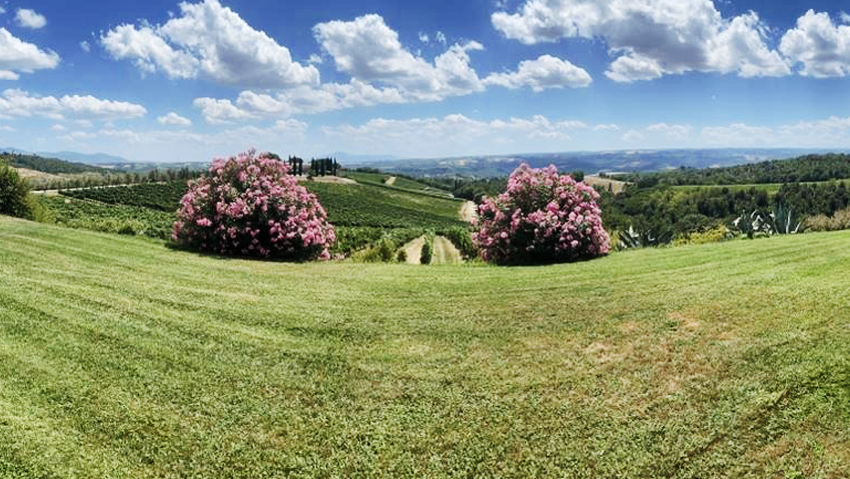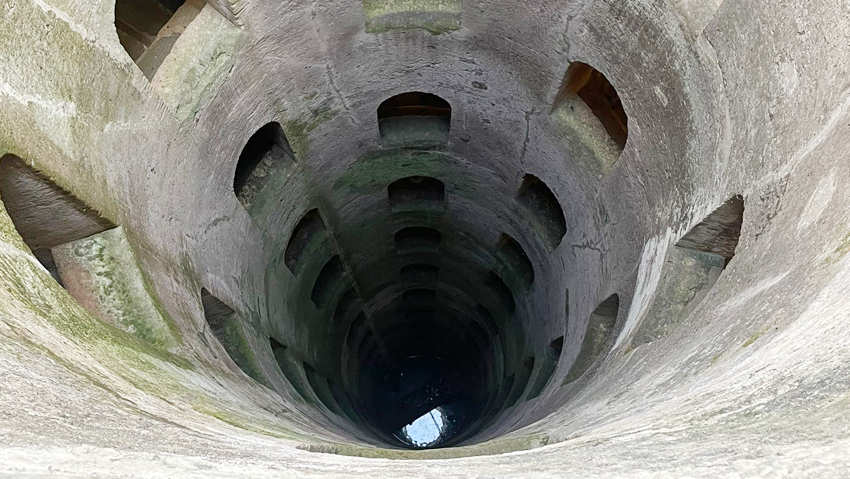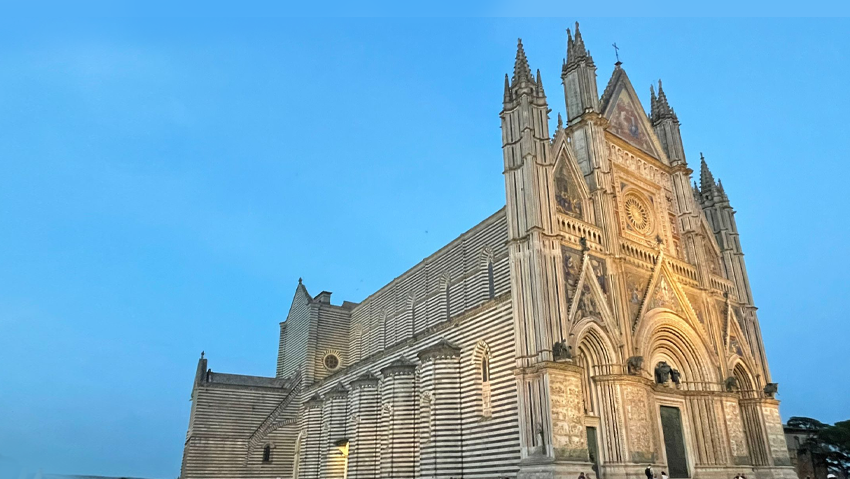White Wines Of Orvieto in Umbria: Heroic Wines Since The Time Of The Romans

Umbria: It’s not Tuscany!
Overshadowed by its wealthier and more well recognized neighbor, Umbria offers a slower, more down to earth, contadino perspective. Less glitzy, glamorous and crowded, Umbria beckons the Italian tourist who wants to dig deeper into Italian culture and traditions.
Why visit: Orvieto is a historically important city in the only landlocked province in Italy. The city sits on a hilltop with the original city carved out of the tufo limestone that was extracted from the hill below.

Another unique visit is to Saint Patrick’s well (Pozzo di San Patrizio) commissioned by Pope Boniface 8th in 1527 to provide a secure source of water for Orvieto.

Antonio di Sangallo’s ingenious double helix design allowed for mule drawn carts to descend one spiral staircase while others could ascend without running into one another. The architect included arched windows cut into the tufo which allow for light to enter. Be sure to wear athletic shoes if you intend to climb up and down the 500 slippery steps.
Note: Many places (including museums, churches, restaurants and some hotels) are not air conditioned and temperatures often soar above 100 degree Fahrenheit for weeks on end in the summer. There is virtually no crime or police presence in Orvieto. It’s a safe place to walk at night.

Food in Orvieto
Lumachelle are delicious snacks of dough stuffed with salami, prosciutto or cheese.
Umbria is a breadbasket in italy producing significant quantities of wheat, beans including lentils (from Castelluccio) and garbanzos (cecchi). Umbricelli is a local pasta similar in shape to the Tuscan pici pasta. Truffles (tartufi) grow in the region, especially in the higher altitude hills. A warming climate means there are fewer freezes and less moisture in the soil that allow for ideal conditions for truffles, especially the black summer truffles. White truffles are prized and are very expensive. The black truffles sell for around 100 euros a kilo whereas the white truffles in the fall can sell for up to 350 euros for 100 grams. Wild boar (cinghiale) and rabbit (coniglio) seem to be present on most menus. Beef from Chiannina cows from the nearby Chiana Valley is served in the same was as bistecca Alla fiorentina: rare on bone with lemon, salt and olive oil. In general, prices in Umbria are 20-35% less than neighboring Tuscany.
A Summary of the Wineries We Visited in Orvieto Doc in Late June 2022
Altarocca is an excellent BIO certified organic winery located on top of a rock for the name. The Orvieto Classico Bianco is an excellent example of the genre. The classico superiori is different from most in that it has 20% Chardonnay Fermented and Barrel and aged for three months. The owners an amiable and excellent host who runs an agriturismo and a well regarded restaurant.
Argillae is a passion project launched in the 1980s by an important spirits producer and distiller. The winery is now in the hands of a mother-daughter team producing noteworthy wines at a modern estate. The wines are all well made. Keep an eye out for the Orvieto Classico Panata. Giulia is the innovative granddaughter of the founder, and her passion project is the Primo d’Anfora wine that is aged in clay amphora made from the clay soils that cover the property. These soils also inspire the name of the property (argilla = clay). She is also producing a charmat method sparkling wine of native grape varieties.
Barberani is an important winery historically and interesting as one of the first to resurrect the Muffa nobile which is the botrytized sweet wine of the region and is ancient tradition in Orvieto. The Orvieto Classico superiore Luigi e Giovanna made from 85% Grechetto and 15% Trebbiano Toscano (aka Procanico) is dedicated to the winery founders. The winery tasting room in the city center in front of the Duomo is worth a visit.
Bigi is one of the larger wineries in the region although it recently sold all of its vineyards and is now more of a bottler or than an estate winery. Dating from 1880, the winery produces wine from one of the “grand cru” vineyards of the region, Vigneto Toricella which overlooks Lago di Corbara.
Cantina Cardeto is a cooperative winery with 150 members that produces the classico Bianco and classico superiori as well as muffa nobile.
Cantine Monrubio is the largest and most important cooperative winery in the region. It started out in 1957 with 80 some growers and now includes over 400 member growers covering more than 1200 hectors in the Orvieto Doc. Ricardo Cottarella was born in the town of Monterrubio and is the consulting winemaker and directs the commercial side of the business. In spite of being one of the largest wineries in the region Monrubio sells the vast majority of their wine in bulk to bottlers outside the region in Tuscany, Piemonte, and Veneto. Their current release of classico Bianco and the Papabile a classico superiori white blend are outstanding examples from the region. Surprisingly the winery is currently bottling only around 40,000 bottles.
Castello della Sala is the Antinori property in Umbria and sits above huge caves carved out of the hills. The large castle dates from 1350 and sits on a hilltop that climbs to 550 meters. Pinot noir is grown at the top of the hill. Acquired during a time with many large wineries from outside the region started to acquire land at low prices Castello della Sala was in ruins when it was purchased. The winery as with many of the Antinori properties is run by Renzo Cotarella. The San Giovanni della Sala Orvieto Classico superiore is a blend of Grecchetto, Procanico, and Viognier and is one of the best white wines from the region. Cervaro is a barrel fermented Chardonnay which is one of the most awarded white wines in Italy. The winery also makes a Muffato nobile there which is one of the best sweet ones in the region with incredible aging potential.
Castello di Corbara enjoys views of the dammed Lago di Corbara and is well regarded for the Sangiovese and Cabernet Sauvignon wines it produces.
Castello di Montegiove has been owned by a Danish-Italian family since the mid-eighteenth century. Located at the far northeast corner of the DOC, the winery sits atop a hill with panoramic views toward Assissi, Perugia, and Tuscany. This is one of the largest estates in the region with over 600 hectares. The winery sources white wine from volcanic soils from cooler areas and makes well regarded red wines. The Sangiovese and Canaiolo Nero Orvietano Rosso blend fermented in stainless tanks is an excellent value red and one of the best in the region for its purity of fruit. Umbria Rosso Elcius is a blend of Montepulciano and Sagrantino worth finding.
Cirulli Winery has a regional perspective about wines and winemaking. In 1861, Valentino Cirulli’s great-grandfather planted vines in Abruzzo. The current generation expanded the vineyard holdings to include parcels in Lazio and Umbria. As a result, some of the wines are interesting and unique “vini di italia” designated wines. Castelnoha is the main facility outside of Orvieto that blends a historic villa with a medieval monastery and modern production facility. The winemaker trained with Riccardo Cottarella. The winery produces three lines. Viteliu mirrors the families various plots as it blends Montepulciano, Tintillia from Molise and Aglianico.
Custodi is led by sisters Laura and Chiara Custodi. They have successfully grown their production to a medium sized 70,000 bottles. Volcanic and clay soils are highlighted in their Classico Belloro bianco.
Decugnano Dei Barbi is led by enterprising Enzo Barbi, son of the founder. The estate is a gorgeous hilltop property with an updated villa with pool that is available to rent on Airbnb. The sand and clay soils are filled with fossilized shells. Several of the wines from this estate set the bar for the regjon. The white wines are all well made examples of Orvieto Classico and Orvieto superiore. The sparkling wines are hand riddled in the ancient caves carved into the hilltop and are among the best examples of the region. There is a brut and a brut zero wine both made in the traditional method. The Orvieto Classico superiore Pourriture Noble is the name for the Muffa nobile and the Barbi were among the first to resurrect this historically important wine in 1974. This wine should certainly be considered among the great sweet wines not only in Umbria but all of Italy. A blend of 60% Grechetto and Procanico, 35% Sauvignon and 5% Semillon , this wine bests many Sauternes.
The Barbi family is originally from Brescia where to this day they operate a large negociant business. Enzo’s aunt manages nearby Podere Barbi and the wine for this estate is still bottled in Brescia.
Paolo e Noemia D’Amico is owned by a successful family who owns a shipping company. Art lovers will appreciate the modern estate with famous artworks including an original Banksy.
Falesco is owned by Renzo and Riccardo Cottarella. The wines are considered some of the best, most consistent and widely distributed in Umbria. Riccardo is a famous flying wine consultant, recognized as one of the best in Italy and the world. He is also a university professor.
La Carraia is a winery that was launched by a local farmer and businessman in partnership with Riccardo Cotarella. This is a larger production of almost 700,000 bottles. The red wines are of particular interest with the Sangiovese leading the way. The “classic” Sangiovese made fresh and young in stainless tank was probably the most interesting wine. The Tizzonero is a heavily oaked red wine. Solcato and Fobiano are two other deeply concentrated red wines.
Sergio Mottura is located in the far southern part of the DOC. A standard bearer in the region since 1933, the wines are globally distributed. Famously, Latour a Civitella is a wine developed with the help of Louis Fabrice Latour, the negociant from Burgundy.
Tenuta Le Velette is larger property with over 270 hectares and is highly recommended. The current family has owned the property since 1870. However, the property has Etruscan caves that are over 3,000 years old. There is also a eighteenth century Jesuit church on the property. Lunato is the name of the Orvieto Classico superiore. Sole Uve is the barrel fermented Grechetto worth seeking out. If you do visit the lovely estate, try to meet Corrado, the gentleman philosopher who is a wealth of knowledge and wisdom in the area.
Vitalonga is known more for its red wines including the Terra di Confine “borderland” wine made from Montepulciano. Tourists to the region will be interested in the well appointed agriturismo Casale Vigneria, which is popular as a site for destination weddings.
Here’s What You Need to Know About Orvieto DOC Wines
Orvieto is one of the most ancient towns dedicated to wine production. The hillside cliffs of tuff (porous limestone rock) have been inhabited since the Etruscan era, in the ninth century BC nearly 3000 years ago. The name Arrieta comes from “Urbus Vetus”or old town in Latin. As a result of the natural protection afforded by the hill and its strategic location in the center of Italy Orvieto had to have a population of more than 30,000 people between the 13th and 14th century, larger than that of Rome at the time.
In the past, wine fermentation took place under the city of Orvieto in the limestone caves. These cool caves provided an optimal, cool temperature for fermentation. Brilliant engineers of the time created a gravity fed winery on three levels. Grapes would be received and pressed (likely foot stomped) on the top level, pressed on the second level and drained to storage vessels (clay amphora) on the third level. The cool temperature also meant that the resulting wine did not finish its alcohol fermentation, leaving the resulting wine with residual sugar. This luxuriant sweet wine became famous among wealthy Romans and the Pope. Over time, the famous white wine became more dry, which also reflected changing tastes of consumers.
In the late 19th century, producers like Luigi Bigi and Marcello Bottai developed commercial wine estates. Until the 1960’s, much of Italian agriculture was performed under mezzadria, a sharecropping system where half of the production went to the workers who lived on a property and half to the landowner. Quantity was prized over quality. Around this time, Tuscan Sangiovese wines from the nearby Chianti region became a global phenomenon. Large producers like Antinori and Ruffino looked to Orvieto for a white wine companion wine to sell. As a result, investors from other regions in Italy began to acquire vineyards and estates in need of renovation, updating, and investment. In 1974, Luigi Barberani and Claudio Barbi rediscovered and revived the classic winemaking tradition of sweet wine production that incorporated botrityzed grapes “muffa nobile” (noble rot) similar to Sauternes wines from Bordeaux.
No discussion about the evolution of Orvieto wine production in the modern era since the 1980’s can be had without mentioning the fundamental influence of brothers Renzo and Riccardo Cotarella. Renzo has been the wine director at Antinori’s Castello della Sala and set a high bar for quality wine production from the region. The Chardonnay with a touch of Grechetto white blend Cervara is one of the most awarded white wines in Italy. The San Giovani Orvieto Classico Superiore DOC bianco blend is one of the finest white wines that uses the traditional grapes Grechetto and Procanico (aka Trebbiano Toscano). The Antinori Muffato Nobile sweet wine is also among the best sweet wines in the region and even all of Italy. Ricardo Cotarella is considered one of the finest winemakers in Italy and has worked as an international wine consultant. He is a shareholder at the largest winery in Orvieto, Monrubio and at La Carraia. The brothers joined forces at Falesco and now their daughters are involved in the Famiglia Cotarella brand. Their technical guidance, leadership and influence is felt throughout Umbria.
To date, the vast majority of Orvieto Bianco is exported to bottlers outside of the region. As of 2022 there are only 35 winery members of the Orvieto DOC. As a result, bulk blended wines remain the norm and the pursuit for quality estate wines continues. Savvy wine enthusiasts would do well to seek out estate wine producers of Orvieto Classico for its easy to drink quaff-ability and value. Many wine collectors will be surprised to find that top Orvieto Classico Superiore white wines can be aged for up to 7-10 years and develop beautifully. Orvieto is one of the few regions where you can buy a white wine at an economical price between $18-30 where the wine is good enough and interesting enough to be aged 5-10 years.
It’s important to note that the central valley of Umbria was once covered by ocean. Fossils and marine deposits litter the calcareous soils. Four key soil types have been identified:
Tasting 4 Soil Types of Orvieto DOC Bianco
- Alluvial - resulting from erosion of surrounding hills into the valleys clean, good, bright lemon citrus, green apple malic
- Clay soil - retains moisture, more weight, more round, more texture
- Sandy - allows for drainage, more crisp, 2020, longer finish, marine chalky, more closed on the nose
- Volcanic - resulting from volcanic activity that created the area, wet stone persistence, 2 minutes
The disciplinari for the DOC requires that Orvieto Classico wines have a minimum combined 60% of Grechetto (both Grechetto di Todi and Grechetto di Todi) and Procanico (a biotype of Trebbiano Toscano aka Ugni Blanc). The remaining 40% may be a combination of Drupeggio, Verdello, Malvasia Bianca lunga as well as international varieties including Chardonnay, Sauvignon Blanc, Vermentino, and Viognier among others.
Two Types of White Wines Are Designated
- Classico DOC
- Classico Superiore DOC
The difference is that the Classico Superiore DOC wines require a minimum alcohol level, have lower yields and five months minimum aging requirement.
Based on the residual sugar content of the resulting wine, wines may be classified as Secco (dry), Abboccato (medium-dry), amabile (medium-sweet) or dolce (sweet). More recently vendemmia tardiva (late harvest) and Muffa Nobile (noble rot) have also been added to include the high-quality sweet wines from the area. In addition introducers are also producing sparkling ones made from both of Charmat and the traditional classic method. Around 500,000 bottles of Rosso Orvietano is also produced in the region although this represents less than 5% of the total production. The most common varietals planted are Sangiovese and Merlot, with some Cabernet Sauvignon among others used in the blends.
Contact information for Orvieto Wineries.
Big Hammer Wines
The wine experts at Big Hammer Wines taste thousands of wines every year from around the globe, looking for quality and value. This special offer reflects the passion we have for our clients.
Discover the world through its wines, Click Here! Visit Bighammerwines.com and become a wine expert!
Leave a comment (all fields required)
Comments will be approved before showing up.


